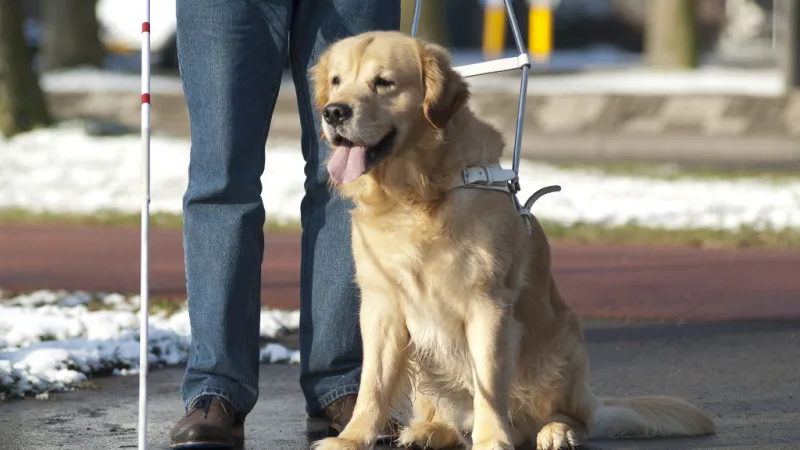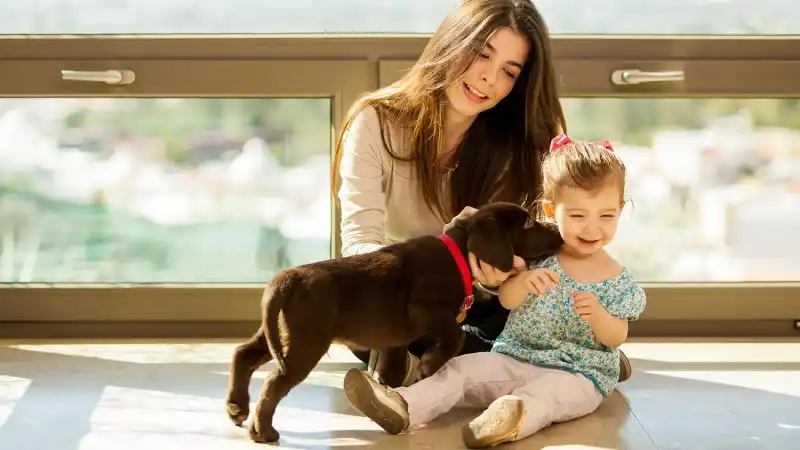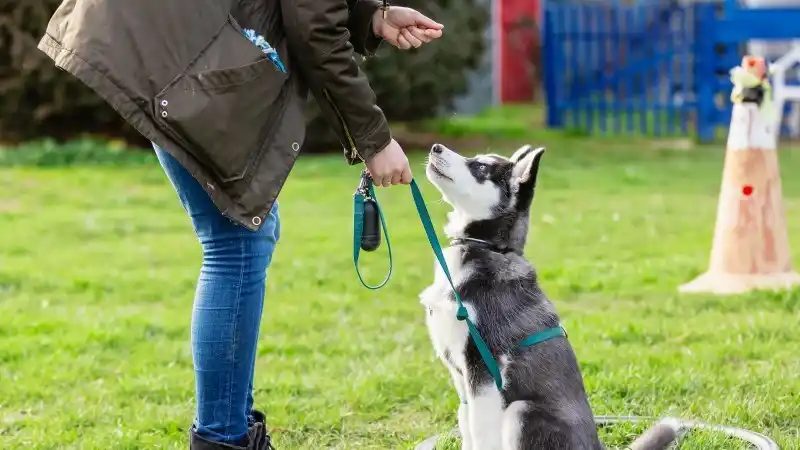How Service Animals Go from Puppies to Lifesavers
Service dogs provide safety, comfort, and independence to people with disabilities. We define service dog and discuss the selection and training process.

Service animals play a crucial role in their humans’ lives, giving them the safety, assistance, and independence they may not be able to attain on their own. They go through rigorous training and certification to be classified as a service animal, which makes them unique from emotional support animals and therapy animals.
To learn more about what goes into training a service animal, we spoke with Carrie Simmons, the Director of Advancement at Paws With A Cause® (PAWS). PAWS is a non-profit organization specializing in the training and placement of service animals to people in need. Founded in 1979, they are one of the oldest service animal groups in the country and have placed more than 3,000 Service Dogs with clients nationwide.
What Is a Service Dog?
Service Dogs are trained to help people with disabilities live a better life. They may guide the blind, identify blood sugar issues in diabetics, assist in making getting around easier, or even help ease the effects of post-traumatic-stress disorder.
PAWS exclusively specializes in training Hearing Dogs, Mobility Service Dogs, Seizure Response Dogs, and Service Dogs for Children with Autism. Their program and trainers focus on these specialties, because no two clients have the same needs.
Service Dogs receive certification to perform their expected tasks. They must be able to prove that they are not only capable of performing the tasks their human needs, but can also do so in public, crowded spaces, or anywhere their human needs to go. Because of this, Service Dogs are protected under the Americans with Disabilities Act (ADA) and have full-access rights to businesses and public spaces. Emotional support animals and therapy animals do not have the same protections because they do not have the same certifications, so Service Dogs are treated differently, and are always on duty.
How Are Service Dogs Selected?
Service-Dog selection can vary by the organization running the training program. Some programs adopt shelter dogs and work with several breeds, but others, like PAWS, have their own breeding program. According to Carrie, “Our breeding program selects the top dogs from our current pack of available dogs. They are selected based on their health, temperament, and skills in training. Each potential breeder goes through rigorous health testing focusing on their eyes and hearts to ensure there are no genetic issues that may be passed onto puppies. We also look at their genealogy going multiple generations back to ensure each pair can safely be bred together.”
PAWS works with four breeds: Golden Retrievers, Labrador Retrievers, Papillons, and Standard Poodles. The Labs, Goldens, and Poodles work as Mobility Service Dogs, Seizure Response Dogs, and Service Dogs for Children with Autism, with the Poodles being bred specifically to assist those with allergies.
Papillons are much smaller and are trained to assist as Hearing Dogs. They alert their deaf or hearing-impaired humans to sounds like sirens or fire alarms, and can even be trained to alert deaf parents to their crying child.
While PAWS specializes in specific breeds, any dog can be a Service Dog if they are properly trained and certified. Some breeds have naturally calmer temperaments and respond better to training than others, but ultimately, it is the individual dog that makes the difference.
How Do You Train a Service Dog?
A Service Dog should be trained based on the needs of the client. PAWS takes this part of the process very seriously to ensure dog and client are a perfect match. PAWS puppies are born in a volunteer home with their mama dog and stay there for 8 weeks. They are monitored by PAWS vets before going to foster puppy raisers, who raise the pups from weeks 8-14.
During their time with puppy raisers, a PAWS pup will go to weekly classes for low-level obedience with a PAWS trainer. This is where the puppy will learn the basics like sit, come, and how to walk on a leash. They will also be exposed to materials that will be involved in their more advanced training. For example, if the puppy is destined to become a Mobility Service Dog that needs to be able to open door handles, they will be given a metal spoon so they can be comfortable with the feel of metal in their mouth.
As they get older, PAWS trainers and breeders will evaluate each dog to see if they should remain in the breeding program or go on to be Service Dogs. Though uncommon, dogs that are not considered ready for training are placed in other working careers. There are many working career options available, so each puppy leaves the program with a purpose.
Who Trains Service Dogs?
PAWS trainers are full-time employees of the charity. They are hired with some basic dog-training experience, and start their careers in weekly sessions with puppies focusing on low-level obedience training. They work with high-level trainers to learn and grow.
Most of the high-level trainers have journeymanships with the U.S. Department of Labor’s 3-year program for assistance-dog training. They work with all four training specialties, and it is their job to not only get a dog ready for their new role, but to individualize the program for that specific client’s needs.
Once accepted into the program, a representative from PAWs gets to know the client, visits their home, and video tapes their daily life, so the trainers can customize a program for that client’s needs. Each dog is custom trained for a specific client. When the dog is ready to go to their new home, the trainers visit frequently for the first six months to not only make sure the dog is behaving as trained, but also to train the client on the commands.
Initially, trainers will visit daily, then weekly, then less frequently based on client needs. Around the 6-month mark, the trainers will go in and test the client/dog team and certify them. It is very rare that a PAWS client/dog team doesn’t mesh well, due to the long, detailed pairing process. However, if for any reason it doesn’t work out, the PAWS team will work to find that client the right dog.
How Do You Decide Who Needs a Service Dog?
Disabilities that warrant a Service Dog are defined by the ADA, so groups like PAWS function under that umbrella. PAWS gets over 400 applications each year, but are only able to place between 50-70 dogs during that time.
After reviewing that a client meets the requirements set by the ADA, PAWS look at what dogs they have available and what the client’s needs are to ensure they have a dog that can help. Because the demand is so high, PAWS focuses on clients that have a higher or active need. For example, if a potential client has seizures that are being controlled effectively with medication, they will not get set up with a dog immediately. Instead, PAWS focuses on the greatest needs.
The whole process takes 12-18 months once an application is accepted, so they are constantly working to help new clients get the support they need.
How Much Does It Cost to Place a Service Dog?
PAWS estimates the process from birth to home costs at about $35,000 per dog. As a non-profit, they work exclusively on donations to provide their dogs to clients in need at no cost to them. Like many non-profits that work with Service Dogs, they do not get government assistance or grants, so donations are where their funds come from.
How Can I Help Service Dogs?
Carrie says, “Service Dogs can be a lifeline for our clients. When [you] see a Service Dog out in public, don’t try to engage them. Let them remain focused on the client and not the people around them.” Ultimately, groups like PAWS need financial support and awareness. If you want to support a group, donate financially, follow and share them on social media, or volunteer with a group near you.
Service Dogs have a job to do, so respect them, don’t distract them, and grant them access to the spaces their human needs to go.
Want to learn more? Check out the PAWS newsletter.
Pet insurance can help pay for unexpected vet bills. Get a dog insurance quote from AKC Pet Insurance today (underwritten by Independence American Insurance Company) and prepare for accidents, illnesses, and much more.
CJ has always wanted to be a writer. She even threatened to drop out after her first day of kindergarten when they weren’t immediately going to teach her to read and write. Fortunately, she stayed in school, earned her degree in Creative Writing from Christopher Newport University, and now gets to live her best life with her husband, 3 Japanese Chins, and cat writing for AKC Pet Insurance.
READ MORE ARTICLES

